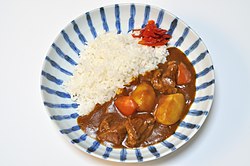 A plate of Japanese-style curry with rice | |
| Type | Curry |
|---|---|
| Place of origin | Japan |
| Serving temperature | Hot |
| Main ingredients | Vegetables (onions, carrots, potatoes), meat (beef, pork, chicken) |
| Variations | Karē raisu, karē udon, karē-pan |
Japanese curry (カレー, karē) is commonly served in three main forms: curry over rice (カレーライス, karē raisu), curry udon (curry over thick noodles), and curry bread (カレーパン, karē pan) (a curry-filled pastry). It is one of the most popular dishes in Japan.[1] The very common "curry rice" is most often referred to simply as "curry" (カレー, karē).
Along with the sauce, a wide variety of vegetables and meats are used to make Japanese curry. The basic vegetables are onions, carrots, and potatoes. Beef, pork, and chicken are the most popular meat choices. Katsu curry is a breaded deep-fried cutlet (tonkatsu; usually pork or chicken) with Japanese curry sauce.[2]
Curry originates in Indian cuisine and was brought to Japan from India by the British. Since the introduction of curry, it was reinvented to suit Japanese tastes and ingredients. Japanese curry has little resemblance to curries from other regions. The dish has changed and been adapted so much since its introduction that it stands on its own as uniquely Japanese. The combination of sweet, sticky Japanese short-grain rice with a thickened curry sauce has led to the unique evolution of Japanese curry. The dish became popular and available for purchase at supermarkets and restaurants in the late 1960s. It is so widely consumed that it can be called a national dish.[3][1][4]
In the UK, katsu curry is sometimes applied to any type of Japanese curry.[5]
- ^ a b 『カレーライス』に関するアンケート (in Japanese). ネットリサーチ ディムスドライブ. Archived from the original on 23 October 2021. Retrieved 1 February 2016.
- ^ "Chicken katsu curry". Food recipes. BBC. 2016. Archived from the original on 14 July 2021. Retrieved 20 January 2016.
- ^ Cite error: The named reference
times-currywas invoked but never defined (see the help page). - ^ カレーライスを国民食にした日本のごはん篇 (in Japanese). Mitsubishi Electric. Archived from the original on 20 February 2024. Retrieved 20 February 2024.
- ^ "The U.K. Thinks Japanese curry is katsu curry, and people aren't happy about it". 12 February 2020. Archived from the original on 17 May 2021.